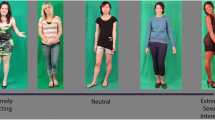Abstract
The effects of a new stimulus following repeated exposure to a familiar, sexually explicit stimulus were studied. Female and male subjects (N =56) viewed an explicitly heterosexual film daily for 4 days and then were exposed to either (i) a film showing the same actors engaging in different sexual acts or (ii) one with different actors engaging in the same activities shown in the original film. Analyses of self-rated responses showed that negative affect significantly increased with film repetition and returned to original levels with the introduction of novelty. Erotophobia was associated with negative affect. Results for self-reported sexual arousal and concern ratings revealed sex differences, with males becoming more aroused and concerned by novelty consisting of different actors, and females becoming more aroused and concerned by the same actors performing different acts. Affective and cognitive theories of human sexual responding provided possible explanations for these results.
Similar content being viewed by others
References
Bandura, A. (1969). Social learning theory of identificatory processes. In Goslin, D. A. (ed.),Handbook of Socialization Theory and Research. Rand-McNally, Chicago, pp. 183–232.
Bandura, A. (1977).Social Learning Theory. Prentice-Hall, Englewood Cliffs, NJ.
Beach, F. A., and LeBouef, B. J. (1967). Coital behavior in dogs. I. Preferential mating in the bitch.Anim. Behav. 15: 546–558.
Berlyne, D. E. (1966). Curiosity and exploration.Science 153: 25–33.
Bleda, P. R., Bell, P. A., and Byrne, D. (1973). Prior induced effect and sex differences in attraction.Mem. Cognit. 1: 435–438.
Brickman, P., Redfield, J., Harrison, A. A., and Crandall, R. (1972). Drive and predisposition as factors in the attitudinal effects of mere exposure.J. Exp. Soc. Psychol. 8: 31–44.
Byrne, D. (1977). Social psychology and the study of sexual behavior.Pers. Soc. Psychol. Bull. 1: 3–30.
Byrne, D. (1983). The antecedents, correlates, and consequents of erotophobia-erotophilia. In Davis, C. M. (ed.),Challenges in Sexual Science: Current Theoretical Issues and Research Advances. Society for the Scientific Study of Sex, Syracuse, NY.
Carr, W. J., Demesquita-Wander, M., Sachs, S. R., and Maconi, P. (1979). Responses of female rats to odors from familiar vs. novel males.Bull. Psychon. Soc. 14: 118–120.
Clemens, L. G. (1967). Effect of stimulus female variation on sexual performance of the male deermouse. Peromyscus Maniculatus.Proceedings 75th Annual Convention of the APA, pp. 119–120.
Dewsbury, D. A. (1981). Effects of novelty on copulatory behavior: The Coolidge effect and related phenomena.Psychol. Bull. 89: 464–482.
Geer, J. H., and Fuhr, R. (1976). Cognitive factors in sexual arousal: The role of distraction.J. Consult. Clin. Psychol. 44: 238–243.
Goldstein, J. H. (1970). Repetition, motive arousal, and humor appreciation.J. Exp. Res. Pers. 4: 90–94.
Griffitt, W. (1973). Response to erotica and the projection of response to erotica on the opposite sex.J. Exp. Res. Pers. 6: 330–338.
Griffitt, W. (1981). Sexual intimacy in aging marital partners. In Marsh, J., and Kiesler, S. (eds.),Aging: Stability and Change in the Family. Academic Press, New York, pp. 301–315.
Howard, J. L., Reifler, C. B., and Liptzin, M. B. (1971). Effects of exposure to pornography. InTechnical Report of The Commission on Obscenity and Pornography, Vol. 8. U.S. Government Printing Office, Washington, D.C.
Kelley, K. (1982). Predicting attraction to the novel stimulus person: Affect and concern.J. Res. Pers. 16: 32–40.
Kelley, K. (1985). Sex, sex guilt, and authoritarianism: Differences in responses to explicit heterosexual and masturbatory slides.J. Sex Res. 21: 68–85.
Kelley, K., and Byrne, D. (1983). Assessment of sexual responding: Arousal, affect, and behavior. In Cacioppo, J., and Petty, R. (eds.),Social Psychophysiology. Guilford, New York.
Krames, L., Costanzo, D. J., and Carr, W. J. (1967). Responses of rats to odors from novel versus original sex partners.Proceedings 75th Annual Convention of the APA, pp. 117–118.
Law, O. T., and Gerbrandt, L. K. (1967a). Sexual preference in female rats: I. Choices in tests with copulation.Psychon. Sci. 89: 493–494.
Law, O. T., and Gerbrandt, L. K. (1967b). Sexual preference in female rats: II. Choices in tests without copulation.Psychon. Sci. 89: 495–496.
Mann, J., Sidman, J., and Starr, S. (1971). Effects of erotic films on sexual behavior of married couples. InTechnical Report of The Commission on Obscenity and Pornography, Vol. 8. U.S. Government Printing Office, Washington, DC. pp. 170–254.
Mann, J., Berkowitz, L., Sidman, J., Starr, S., and West, S. (1974). Satiation of the transient stimulating effect of erotic films.J. Pers. Soc. Psychol. 30: 729–735.
Michael, R. P., and Zumpe, D. (1978). Potency in male rhesus monkeys: Effects of continuously receptive females.Science 200: 451–453.
Mosher, D. L. (1980). Three dimensions of depth of involvement in human sexual response.J. Sex Res. 16: 1–42.
Mosher, D. L., and O'Grady, K. E. (1979). Sexual guilt, trait anxiety, and females' subjective sexual arousal to erotica.Motiv. Emot. 3: 235–249.
Przybyla, D. P. J., and Byrne, D. (1984). The mediating role of cognitive processes in selfreported sexual arousal.J. Res. Pers. 18: 54–63.
Reifler, C. B., Howard, J., Lipton, M. A., Liptzin, M. B., and Widmann, D. E. (1971). Pornography: An experimental study of effects.Amer. J. Psychiat. 128: 575–582.
Rosenthal, T. L., and Zimmerman, B. J. (1978).Social Learning and Cognition. Academic Press, New York.
Stang, D. J. (1974). Methodological factors in mere exposure research.Psychol. Bull. 81: 1014–1025.
Symonds, D. (1979).The Evolution of Human Sexuality. Oxford University, Oxford.
Wilson, W. R. (1979). Feeling more than we can know: Exposure effects without learning.J. Pers. Soc. Psychol. 6: 811–821.
Wyers, E. J., Adler, H. E., Carpen, K., Chiszar, D., Demarest, J., Flanagan, O. J., Jr., von Glaserfeld, E., Glickman, S. E., Mason, W. A., Menzel, E. W., and Tobach, E. (1980). The sociobiological challenge to psychology. On the proposal to “cannibalize” comparative psychology.Amer. Psychol. 35: 955–979.
Zajonc, R. B. (1968). The attitudinal effect of mere exposure.J. Pers. Soc. Psychol. Monogr. Suppl. 9(2, Pt. 2), 1–27.
Author information
Authors and Affiliations
Rights and permissions
About this article
Cite this article
Kelley, K., Musialowski, D. Repeated exposure to sexually explicit stimuli: Novelty, sex, and sexual attitudes. Arch Sex Behav 15, 487–498 (1986). https://doi.org/10.1007/BF01542313
Issue Date:
DOI: https://doi.org/10.1007/BF01542313




